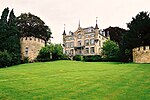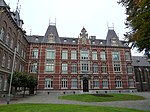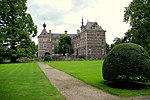Oost Castle

Oost Castle (Dutch: Kasteel Oost) is a manor house in Oost-Maarland, a village in Eijsden, Limburg, the Netherlands. Located along the Meuse, it can be traced to an 11th-century motte-and-bailey residential tower that was expanded several times between 1548 and 1800. After falling into dilapidation, it was renovated in 1848 but had fallen into dilapidation again by the beginning of World War II. Beginning in 1941, an art colony led by Teun Roosenburg and his wife Jopie took residence in the castle. As they worked, trading art for food, the artists smuggled Jewish refugees away from the German occupation. The Roosenburgs purchased the castle in 1957, after which time they made extensive renovations, replacing the 1848-built chalet roof with a flatter design. After their deaths, the castle was acquired by Michel Maes; as of 2024, it is being converted into a luxury hotel. Together with a farmhouse on the grounds, the castle was declared a rijksmonument (national monument) on 17 January 1967.
Excerpt from the Wikipedia article Oost Castle (License: CC BY-SA 3.0, Authors, Images).Oost Castle
Kasteellaan, Eijsden-Margraten
Geographical coordinates (GPS) Address Nearby Places Show on map
Geographical coordinates (GPS)
| Latitude | Longitude |
|---|---|
| N 50.796111111111 ° | E 5.7061111111111 ° |
Address
Kasteellaan 1
6245 SB Eijsden-Margraten
Limburg, Netherlands
Open on Google Maps










